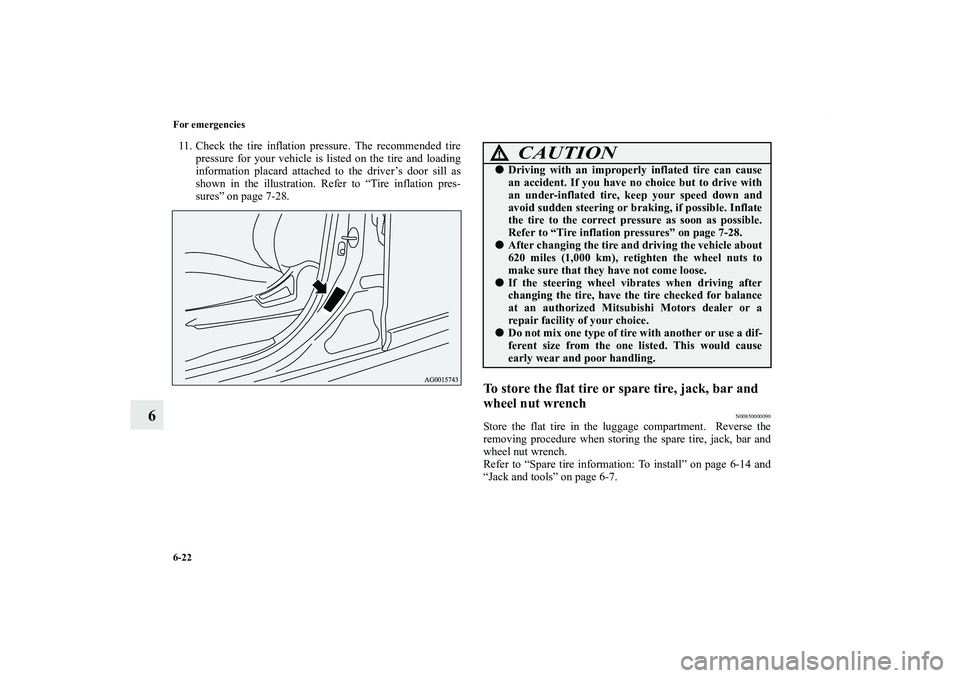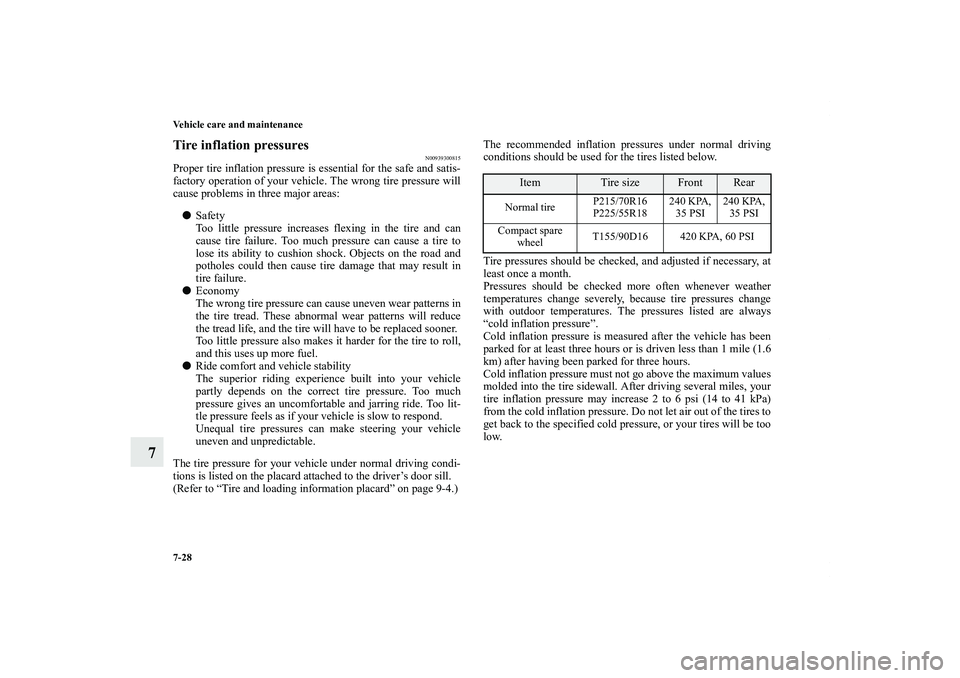Page 583 of 714
6-14 For emergencies
6
To install
N00860500027
1. Place the tire on the center of the tire hanger, with the
wheel surface facing upwards.2. Lift up the tire hanger (A) and hook it on the hook (B).
CAUTION
!�Storing the tire with the wheel surface facing down
may damage the wheel or tire hanger. If you find
any damage on a spare tire, do not use the tire and
contact an authorized Mitsubishi Motors dealer or a
repair facility of your choice.
CAUTION
!�Make sure you hook the tire hanger in the proper
position. If the tire hanger is not hooked properly,
the hook could damage the vehicle body or the tire
could fall off the vehicle while driving, causing an
accident.
BK0122500US.book 14 ページ 2010年5月12日 水曜日 午前11時11分
Page 584 of 714
For emergencies
6-15
6
3. Open the lower gate.
Refer to “Flap-fold tailgate: To open” on page 3-60.
4. With the wheel nut wrench, firmly tighten the tire hanger
mounting bolt by turning it clockwise.
5. Install the cover over the tire hanger mounting bolt.
To change a tire
N00849800418
1. On vehicles with wheel covers, first remove the covers
(refer to “Wheel covers” on page 6-23). Then, loosen the
wheel nuts with the wheel nut wrench. Do not remove the
wheel nuts yet.
CAUTION
!�Confirm that the tire hanger is firmly secured after
storing the spare tire. If the tire hanger is not
secured, it could drop out while driving, causing an
accident.�When hooking or unhooking the tire hanger, be sure
to hold the tire hanger firmly to prevent it from
dropping on your foot.
BK0122500US.book 15 ページ 2010年5月12日 水曜日 午前11時11分
Page 585 of 714
6-16 For emergencies
6
2. Place the jack under one of the jacking points (A) shown
in the illustration. Use the jacking point closest to the tire
you wish to change.
NOTE�Put the spare wheel under the vehicle body near the jack.
This makes it safer if the jack slips out of position.
WA R N I N G
!�Set the jack only at the positions shown here. If the
jack is set at a wrong position, it could dent your
vehicle or the jack might fall over and cause per-
sonal injury.�Do not use the jack on a tilted or soft surface.
Otherwise, the jack might slip and cause personal
injury. Always use the jack on a flat, hard surface.
Before setting the jack, make sure there are no sand
or pebbles under the jack base.
BK0122500US.book 16 ページ 2010年5月12日 水曜日 午前11時11分
Page 587 of 714
6-18 For emergencies
6
5. Remove the wheel nuts with the wheel nut wrench, then
take the wheel off.6. Clean out any mud, etc. on the hub surface (F), hub bolts
(G) or in the installation holes (H) in the wheel, and then
mount the spare tire.�No one should be in your vehicle when using the
jack.�Do not start or run the engine while your vehicle is
on the jack.�Do not turn the raised wheel. The tires that are still
on the ground could turn and make your vehicle fall
off the jack.
CAUTION
!�Handle the wheel carefully when changing the tire,
to avoid scratching the wheel surface.
WA R N I N G
!
BK0122500US.book 18 ページ 2010年5月12日 水曜日 午前11時11分
Page 588 of 714
For emergencies
6-19
6
7. [Vehicle with steel wheels]
• Normal wheels and compact spare wheel
Install the wheel nuts (tapered nuts) with their tapered
ends facing inward, then tighten by hand until the wheel
is no longer loose.
WA R N I N G
!�Mount the spare wheel with the valve stem (I) facing
outward. If you cannot see the valve stem (I), you
have installed the wheel backwards.
Operating the vehicle with the spare wheel installed
backwards can cause vehicle damage and result in
an accident.
BK0122500US.book 19 ページ 2010年5月12日 水曜日 午前11時11分
Page 589 of 714
6-20 For emergencies
6
[Vehicle with aluminum wheels]
• Normal wheels
Temporarily tighten the wheel nuts (flange nuts) until
their flange section comes in contact with the wheel and
it is no longer loose.• Compact spare wheel
Install the wheel nuts with their tapered ends facing
inward, then tighten by hand until the wheel is no longer
loose.
NOTE�Flange nuts can be temporarily used on the compact spare
or steel wheel, but return them to the original wheel and
tire as soon as possible.
�If all 4 wheels are changed to steel wheels, use tapered
nuts.
CAUTION
!�Never apply oil to either the wheel bolts or the nuts
or they will tighten too much.
BK0122500US.book 20 ページ 2010年5月12日 水曜日 午前11時11分
Page 591 of 714

6-22 For emergencies
6
11. Check the tire inflation pressure. The recommended tire
pressure for your vehicle is listed on the tire and loading
information placard attached to the driver’s door sill as
shown in the illustration. Refer to “Tire inflation pres-
sures” on page 7-28.
To store the flat tire or spare tire, jack, bar and
wheel nut wrench
N00850000090
Store the flat tire in the luggage compartment. Reverse the
removing procedure when storing the spare tire, jack, bar and
wheel nut wrench.
Refer to “Spare tire information: To install” on page 6-14 and
“Jack and tools” on page 6-7.
CAUTION
!�Driving with an improperly inflated tire can cause
an accident. If you have no choice but to drive with
an under-inflated tire, keep your speed down and
avoid sudden steering or braking, if possible. Inflate
the tire to the correct pressure as soon as possible.
Refer to “Tire inflation pressures” on page 7-28.�After changing the tire and driving the vehicle about
620 miles (1,000 km), retighten the wheel nuts to
make sure that they have not come loose.�If the steering wheel vibrates when driving after
changing the tire, have the tire checked for balance
at an authorized Mitsubishi Motors dealer or a
repair facility of your choice.�Do not mix one type of tire with another or use a dif-
ferent size from the one listed. This would cause
early wear and poor handling.
BK0122500US.book 22 ページ 2010年5月12日 水曜日 午前11時11分
Page 625 of 714

7-28 Vehicle care and maintenance
7
Tire inflation pressures
N00939300815
Proper tire inflation pressure is essential for the safe and satis-
factory operation of your vehicle. The wrong tire pressure will
cause problems in three major areas:
�Safety
Too little pressure increases flexing in the tire and can
cause tire failure. Too much pressure can cause a tire to
lose its ability to cushion shock. Objects on the road and
potholes could then cause tire damage that may result in
tire failure.
�Economy
The wrong tire pressure can cause uneven wear patterns in
the tire tread. These abnormal wear patterns will reduce
the tread life, and the tire will have to be replaced sooner.
Too little pressure also makes it harder for the tire to roll,
and this uses up more fuel.
�Ride comfort and vehicle stability
The superior riding experience built into your vehicle
partly depends on the correct tire pressure. Too much
pressure gives an uncomfortable and jarring ride. Too lit-
tle pressure feels as if your vehicle is slow to respond.
Unequal tire pressures can make steering your vehicle
uneven and unpredictable.
The tire pressure for your vehicle under normal driving condi-
tions is listed on the placard attached to the driver’s door sill.
(Refer to “Tire and loading information placard” on page 9-4.)The recommended inflation pressures under normal driving
conditions should be used for the tires listed below.
Tire pressures should be checked, and adjusted if necessary, at
least once a month.
Pressures should be checked more often whenever weather
temperatures change severely, because tire pressures change
with outdoor temperatures. The pressures listed are always
“cold inflation pressure”.
Cold inflation pressure is measured after the vehicle has been
parked for at least three hours or is driven less than 1 mile (1.6
km) after having been parked for three hours.
Cold inflation pressure must not go above the maximum values
molded into the tire sidewall. After driving several miles, your
tire inflation pressure may increase 2 to 6 psi (14 to 41 kPa)
from the cold inflation pressure. Do not let air out of the tires to
get back to the specified cold pressure, or your tires will be too
low.
Item
Tire size
Front
Rear
Normal tireP215/70R16
P225/55R18240 KPA,
35 PSI240 KPA,
35 PSI
Compact spare
wheelT155/90D16 420 KPA, 60 PSI
BK0122500US.book 28 ページ 2010年5月12日 水曜日 午前11時11分